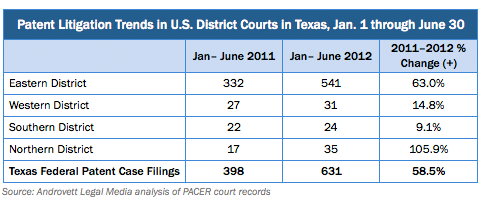© 2012 The Texas Lawbook.
By Eric Findlay
Contributor to The Texas Lawbook
When Congress passed the America Invents Act in September 2011, another law also kicked in: the law of unintended consequences.
President Barack Obama and Republican leadership in the U.S. House of Representatives sold the Act as being “vital to our ongoing efforts to modernize America’s patent laws.” Another intention of the law was to reduce patent litigation.
Yet, in the nine months since the law was signed, new patent infringement filings are up significantly across Texas.
The number of new patent cases filed in the Northern District of Texas during the first half of 2012 more than doubled the number filed during the first six months of 2011. The Eastern District saw its new patent filings jump 63 percent. The Western and Southern districts witnessed significant increases, too.
 In fact, the number of patent-related lawsuits filed in the Eastern District in the first half of 2012 is nearly equal to the number of cases filed for all 2010.
In fact, the number of patent-related lawsuits filed in the Eastern District in the first half of 2012 is nearly equal to the number of cases filed for all 2010.
It turns out the America Invents Act apparently is operating as it was largely intended by forcing plaintiffs to file individual lawsuits against each company or person who allegedly violated their patents. Before the Act, plaintiffs could sue a group of companies on the same or similar patent-infringement claims. If the law’s intention was to reduce patent litigation, its primary effect so far has been to simply split cases into smaller pieces.
That’s why the workload for clerks, lawyers and judges has picked up in the Eastern District and many other district courts whose caseloads center on patent litigation.
Nearly 10 years ago, the Eastern District became a national hub for patent litigation after its judges established a track record for quickly and efficiently resolving patent disputes and implementing local rules that got such cases to trial faster.
With or without the America Invents Act, the Eastern District’s popularity for handling patent litigation isn’t fading. Patent lawsuits in East Texas numbered only 350 in 2005. By 2010, that number had more than doubled. National statistics reflect that trend as well. So far, the America Invents Act isn’t slowing things down at the courthouse.
What, if anything, does this mean to defendants?
For starters, the Act can make these suits easier to defend and easier to transfer to either a home district or one at least perceived to be more “defendant friendly.” One potential drawback, however, can be the increased costs of defending suits as a single party.
Before the America Invents Act, co-defendants could split the costs of what are typically expensive defenses. The expense of retaining experts, patent research and obtaining graphics to support your case can expand quickly, especially if a defendant is paying the costs solo.
Recently, in a few patent disputes against multiple defendants, courts have consolidated cases onto one unified discovery schedule and a single Markman hearing that determines the scope of protection granted for the contested patent.
More complicated issues, such as how cases will be tried, and what disputes can be tried in a single case, won’t be decided by the court until discovery is completed.
Plaintiffs, meanwhile, can expect to pay higher costs because filing and prosecuting multiple cases requires more work than simply suing a group of defendants in a single case. Some of these cases might land in separate jurisdictions, and others might become part of multidistrict litigation, both of which can drive client costs higher.
If you believe in another figurative law – the law of diminishing returns – it would make sense that some plaintiffs might begin to find it too expensive to pursue their pre-America Invents Act plans, or at least to be much more selective in suing.
But there’s too much at stake for most plaintiffs to simply walk away from litigation – patents and other intellectual property will continue to gain in importance and value. Ours is an information economy and there are great competitive advantages and financial rewards for those who can control and leverage that information.
The caseload spike undoubtedly will test the Courts of the Eastern District and elsewhere. But we are already seeing local judges take unique and innovative steps to manage the continually expanding patent docket in order to ensure that all litigants have access to and receive the due process they deserve. Their professionalism and competence won’t allow the quality of justice to suffer.
One remaining question is whether Rule 42 of the Federal Rules of Civil Procedure, which allows judges to consolidate cases based on common issues at law, has been trumped by the America Invents Act. A few cases where this apparent conflict was present already have been decided, but no definitive rulings have been issued. Don’t be surprised if future cases require a bright-line decision from an appellate court.
It’s hard to say what the long-term impacts of the America Invents Act may hold for the federal court system. In the short term, though, it appears that the Act is not preventing companies from sending attorneys to courtroom patent fights.
Eric Findlay is a trial lawyer with 20 years of experience representing a wide range of clients. He has been involved in hundreds of patent cases in the Eastern District of Texas and is the founding partner of Tyler, Texas-based Findlay Craft, LLP, and founding director and chairman of Level2Review.
© 2012 The Texas Lawbook. Content of The Texas Lawbook is controlled and protected by specific licensing agreements with our subscribers and under federal copyright laws. Any distribution of this content without the consent of The Texas Lawbook is prohibited.
